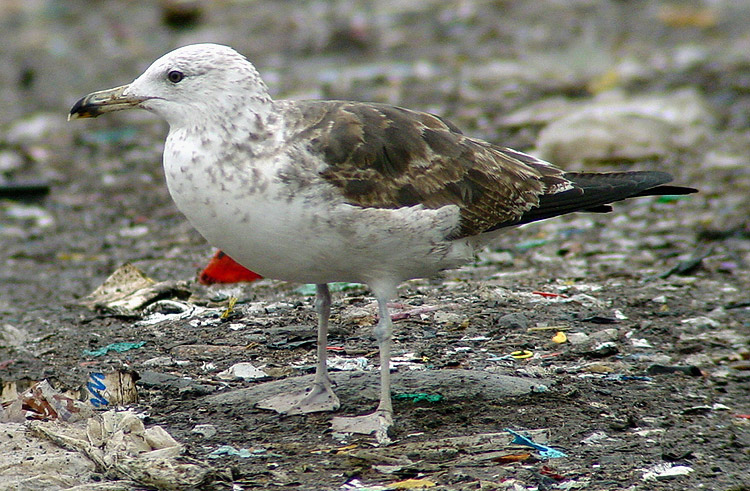(2 images) Larus fuscus fuscus 2cy, July 12 2003, Tampere, Finland (61.33N 24.59E).

Clouded conditions after rain.
An example of classic 2cy fuscus in Finland in July. The second generation wing-coverts and scapulars are worn pale brown with an obvious black shaft-streak and internal barring on the central greater coverts. The primaries were moulted recently and are still glossy black. All primaries, P1-P10 were replaced for second generation flight feathers on the wintering ground and are still present.
In the upper scapulars and outer lower scapulars, new third generation feathers grow in; they appear dark blackish brown, lacking any obvious barring or patterns, except the hardly visible darker shaft-streak. The complete wing-covert panel has been replaced on the wintering ground, all second generation feathers with a pattern of transversal bars, most obvious in the central greater coverts. These feathers are bleached and with the fringes worn away, so the pattern has become indistinct. After arrival in Scandinavia, this bird again started limited moult in the coverts, leaving no obvious moult gaps in the covert rows. The new third generation wing-coverts are plain blackish coverts.
The bare part coloration is still most immature, typical 2cy in July.
This is an example of typical Finnish fuscus, representing average 2cy fuscus in completely replaced primaries, rectrices and secondaries on the wintering grounds, prior to northbound migration. The new second generation primaries are only a couple of months old and still look dark blackish. The second generation tail-feathers normally still show the white tips, but in some individuals these tips are worn away when 2cy birds arrive back in Scandinavia. Immediately after returning in Scandinavia some 2cy fuscus start a new moult cycle in the inner primaries, now growing in third generation feathers.
The complete moult in the winter quarters normally start with replacement of the scapulars and mantle-feathers. The new scapulars often show a simple pattern of a black shaft-streak on a dark brown base. The post-juvenile moult may already start in juvenile birds which are still in Scandinavia in September. When most of the scapulars are replaced, fuscus start to replace the wing-coverts, in the ordinary sequence that can also be found in other gull taxa in Europe. Wing-covert moult is initiated in two loci, one wave starts in the outermost coverts, one wave starts in the innermost coverts. The two waves normally meet at covert #7-8. Normally the median covert row is the first row which is moulted, followed by the lower lesser coverts, the greater coverts and moult finishes in the outer lesser coverts (the carpal edge). If for whatever reason, moult in the wing-coverts is arrested, this is normally most obvious in the carpal edge, containing juvenile feathers which contrast with the other fresh coverts.
In classical 2cy fuscus, all wing-coverts are replaced to second generation on the wintering grounds, and by mid July, a next moult wave is initiated, often including the median and lower lesser coverts, the inner greater coverts, upper tertials and scapulars. Bare part coloration may be very immature, including a black bill, but may also be very mature, with a yellow base and a red gonydeal spot on the lower mandible. Still, these birds are only 12 months old.

|
 nominate Lesser Black-backed Gull (L. fuscus)
nominate Lesser Black-backed Gull (L. fuscus)
